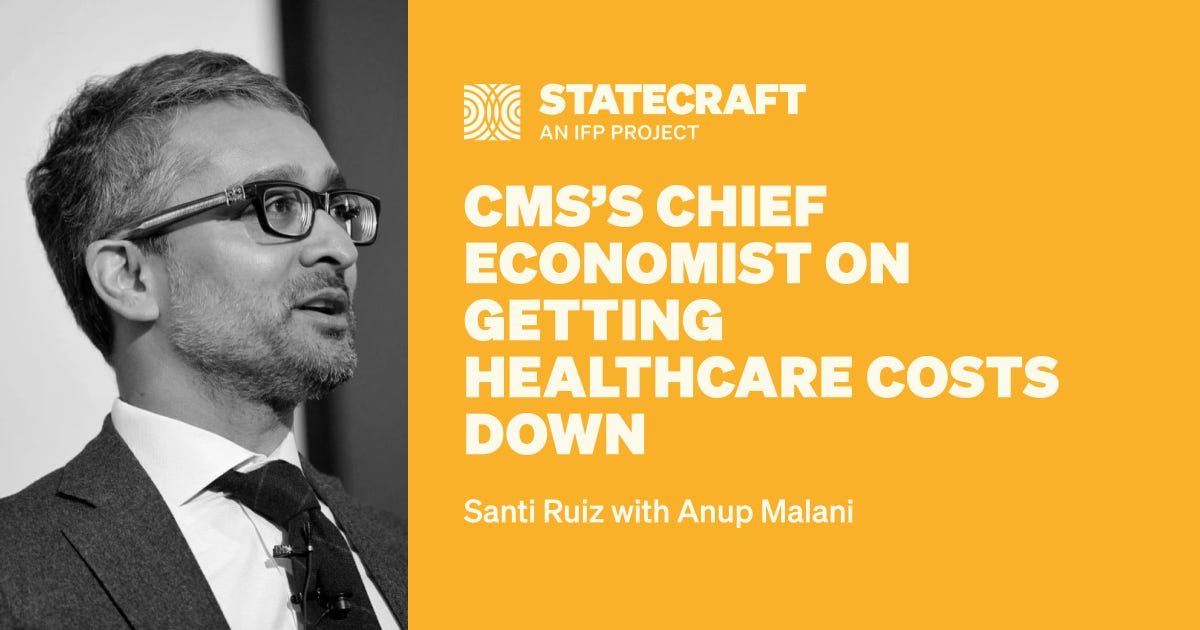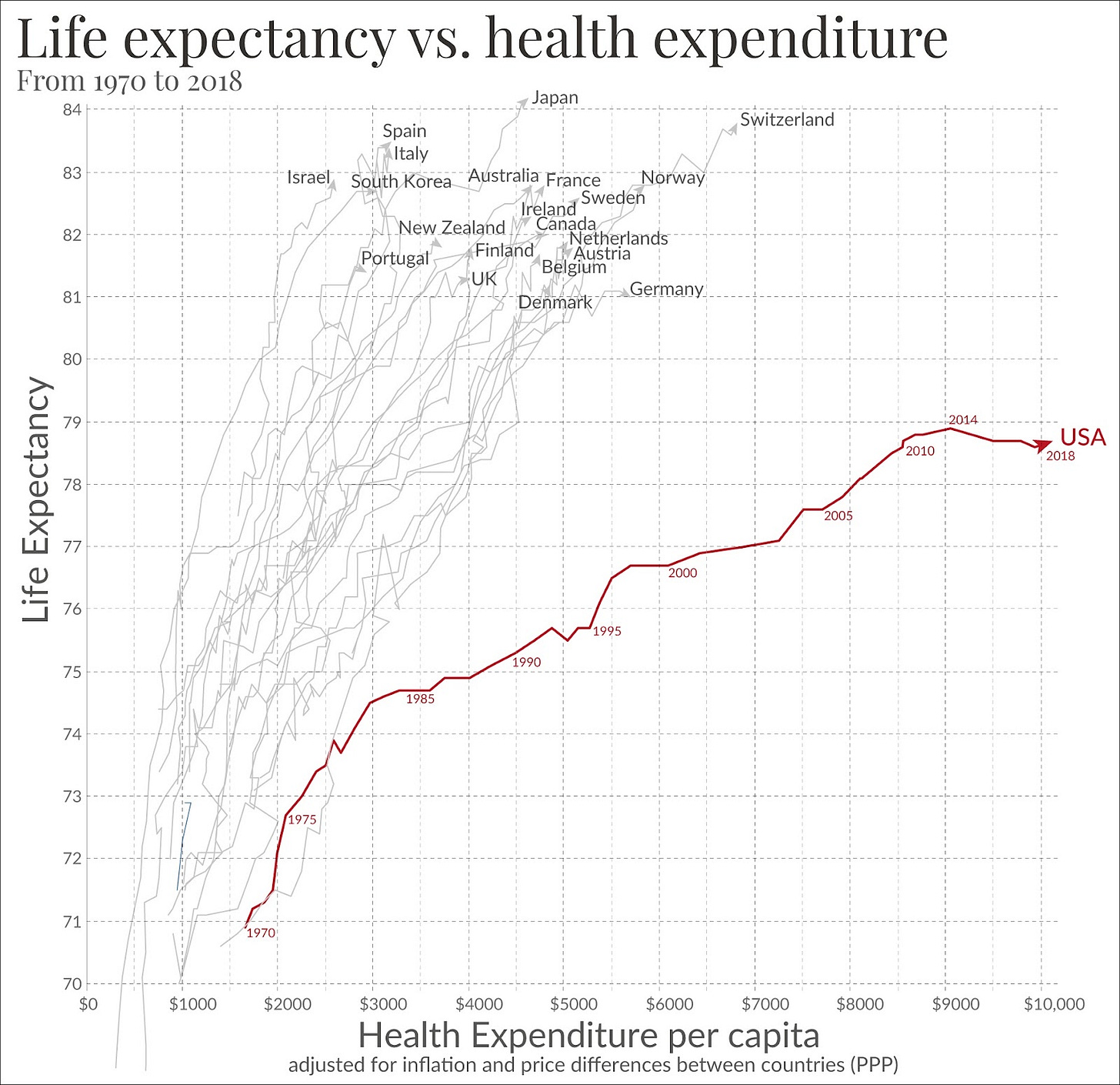Today, I’m joined by Anup Malani. He’s a professor of law at the University of Chicago, currently on leave, serving as the first Chief Economist at the Centers for Medicare & Medicaid Services. This means he oversees economic analysis for the agency managing $2 trillion in annual healthcare spending — 23% of the entire federal budget. CMS runs Medicare for 70 million elderly Americans, Medicaid for low-income families, and the health insurance exchanges where millions buy coverage.
Malani answers a lot of questions I have about American healthcare policy:
The US spends 20% of GDP on healthcare. Why is our life expectancy so bad?
What’s the Trump admin’s plan to crack down on Medicare fraud without hurting patients who need care?
What incentives do private insurers have to make patients look sicker than they are?
What do academic economists get wrong about policy?
Thanks to Harry Fletcher-Wood and Katerina Barton for their judicious transcript and audio edits.
In preparation for this conversation, I realized I owe both you and my dad an apology. I’m a University of Chicago alum, where you teach, but I never took an undergrad econ class. So this is my public acknowledgement to my dad and to you: I should have taken your class.
I have two children going to the University of Chicago. They love the culture and the intensity. But I have one major criticism. You have to take a common set of classes, the Core. Two things that are not included in that common core are shocking to me. You don’t have to take an economics class, and you don’t have to learn about evolution. You can take them optionally, but it’s not required. If you think about two mechanisms that govern life, which are super important to understand, it’s those two.
I would’ve benefited from the econ class. I always put it off. “There are some fun courses this quarter, I’ll tackle econ next year.” And I never got around to it.
Statecraft is me doing remedial econ education. We had Dean Karlan on, Chief Economist at USAID. I talked to Zach Liscow about infrastructure costs. You’re the Chief Economist at the Centers for Medicare & Medicaid Services, or CMS. So I’m getting my econ education, but it’s taking a while.
That’s great. And for those of us who are consumers of your podcast, it’s not just you learning economics — it’s us learning new intuitions about statecraft from you.
It’s good to hear that. But let’s start here: What are you doing all day as chief economist at CMS?
This is the first time there’s been a chief economist at CMS. The very first thing I did was survey what other chief economists and institutions have done — in and outside the government — to see what activities they engage in and how they can be most useful to their organizations. Having done that, I break down my job into three parts.
The first part is to provide advice on prospective decisions. Sometimes there’s writing involved, sometimes just conversations. In either case, there’s some research that involves going to the literature or doing some back-of-the-envelope numbers to advise on immediate and pressing decisions.
Item two is discrete projects, where instead of just providing advice to the decision maker, I’m making most of the decisions. Maybe there’s an updating process that goes on. I tell the administrator what I’m doing and check in to see if he’s got feedback. But roughly, I’m managing the project myself. Often it involves improving economic decision-making in different parts of the organization.
The third item is economic research on questions that are both retrospective and prospective. We may have done a regulation, or there may be a statute and we need to figure out what the impact is. Or we want to do some research to understand a topic that might have a decision forthcoming. Trying to understand, for example, how marketplaces work, or how Medicare Advantage is functioning.
When you did your survey, what were your takeaways?
It’s one of these jobs where there’s no clear definition. You have to make the job. The thing to try to do is to become a trusted advisor to the person that you report to. You need to build up that trust capital because if you want your work to have import, it’s got to be that the decision makers value it.
The thing to avoid is to impose your own preferences. You bring in a set of tools. For me, it’s economic analysis and understanding how healthcare markets and financing programs work. That doesn’t give me the authority to displace people’s preferences. If people don’t follow your advice — and sometimes they won’t — you can’t get angry about it, because they’ll stop asking you. You provide input when they ask, and let them make the decision.
How has it been to go from academia to an environment where major decisions about people’s health have to be made all the time under uncertainty?
The main difference between academia and CMS is the speed and weight of decisions. In any given week, any decision is more important than almost any decision you’ll ever make in academia. From CMS’s perspective, almost all items end with a “B” — billions. Even when there are millions, there are usually nine digits involved.
When you’re an academic economist, you pick your questions, and you take your time to answer them to a certain standard of quality, usually whatever the bar is for getting into a very good journal. You’ll discard questions when you don’t think you can answer them to that level of quality. That’s not a privilege you have when you’re working in the government. Your goal is to say, “What is the best analysis I can do in the time period allotted to make that decision?” But you have to do the analysis.
That means you spend more time than I anticipated letting theory guide you. Basic econ 101 — I would call it price theory, because I’m from Chicago. You learn to treat problems as Fermi problems, where you don’t have all the data, you just need to get an approximate solution. You do back-of-the-envelope calculations as fast as you can. You pray that the literature’s already answered the question. If not, you’ve just got to get what numbers you can quickly and answer the question before the decision has to be made.
What do economists who study healthcare get wrong? Or what do they do that’s unhelpful for decision-makers in policy-making on healthcare?
There’s a disconnect between American health economics research and the decisions that have to be made at CMS. The main thing is not understanding the constraints that decision-makers face here, and there’s a myriad of them. You can’t just toggle switches on and off.
Let me give you a few examples of constraints. When you want to change a regulation, there’s a whole legal process set up by the Administrative Procedures Act (APA): notice and comment. You have internal clearances that add time. On top of that, there’s prudential concerns: making sure you send the signal to the private sector so that they can prepare. You can’t just pass a regulation and expect compliance immediately. If we made a decision today, it might be eighteen months to two years before you can see [it in effect]. That slows down things.
A second issue is political constraints. You have to think about the coalition that is going to support your decision-making and how your decision affects them.
A third issue is the resources for implementing things. Economists think, “Let’s change the premium schedule this way, or provide this little mechanism to provide incentive.” We don’t think, “How do you implement that? How many humans do you need? What tech do you need? What services do you need to have in place? What education do you have to provide to the regulated party to understand exactly how to comply?” That process either may not exist or may take time to construct.
You don’t have a blank slate on which to rewrite rules. Regardless of which administration you work for, people say, “You should just change things to meet this particular...” Oh my gosh! You have to understand when an agency’s inability to take an action is due to constraints versus not being proactive.
Two things should flow from this for academic health economists. The first is, economists should think about the questions that CMS or corporations need answered, as opposed to what is economically interesting in the abstract. That would give research much more impact on the world.
The second is, a lot more [research] should focus on what you would call statecraft, or I would call implementation. “What is the value added by the APA? How does decision-making work in the context of a political coalition? How does personnel economics function in the context of policy decision-making?” There’s work to be done there. One of my goals is to bring health economists through CMS so they can see that firsthand, and hopefully it informs their research when they’re back in academia.
Let me zoom out and ask you a very basic question. The US spends quite a bit of money on healthcare, compared to many other developed countries. We have worse life expectancy outcomes than that big bucket of other developed countries. There’s not one obvious thing that they’re all doing that we’re not that would lead to those discrepancies. What’s going on here?
I’m going to put my academic hat on for a second. I want to be careful about making those assertions — although I probably share your view that we could do much better by both the consumer and the taxpayer in the delivery of healthcare.
The United States roughly spends 20% of GDP on healthcare. But for the last 10 years, we’ve been stuck at 20%. That’s remarkable, because there were all these warnings back in the ‘90s: “We’re increasing spending on healthcare and it’s going to become unsustainable.” But then for a decade, we plateaued and we’re still trying to figure out why. So I want to be a bit careful about that assertion.
From a purely economic perspective, there is no natural percentage of GDP that you’d spend on healthcare. It just depends on the degree to which healthcare is a luxury good. By luxury good, I mean that as you earn more, you spend a higher percentage of your income on that particular item. Healthcare might be a good where, as you increase income, you spend a higher percentage — it could be more valuable to higher-income individuals. So I don’t think that saying, “It’s 20%,” means this is or isn’t too much. You have to give an additional reason why it might be too much.
That’s a useful correction, but still: why do we die several years sooner than the South Koreans, Italians, Swiss, or Germans?
First, you have to understand the inputs into health in the United States versus other places. If the inputs — meaning the underlying health, the human capital of the population — are lower to start with, it might not be that we’re getting a bad result. It could just be that we’re doing pretty good with a worse base.
There’s a super insightful paper by Alice Chen, Heidi Williams [Director of Science Policy at IFP], and Emily Oster that looks at why one-year child mortality is higher in the US than in Europe. They find the gaps in mortality rates don’t emerge in the first month of life: they emerge in months 2 through 12.
Why is that important? If you think about where the healthcare system has the biggest impact, it’s the first month. But the differences in outcomes show up in months 2 through 12. It’s what’s going on back at home that matters. That tells you we may be starting with different baselines. Our population might not have the same longevity, in the abstract, or they may engage in other behaviors that lead to worse outcomes. That’s an important takeaway: health is not the same thing as healthcare. To figure out if our healthcare is doing a bad job, we need to look at places where healthcare is having an impact, and not necessarily where community, families, or activity differ.
The second point is — I value health. But people make health trade-offs. For a lot of my life I skied. Skiing is a health/happiness trade-off. We often trade our health for other things. We need to account for that. We can’t just tell people, “You should always prioritize health.” That lecture doesn’t always work. We need to sometimes take people where they’re standing.
Okay. If spending more on healthcare doesn’t necessarily mean we should expect to live longer, because we might start from a lower base, why are Americans starting from that lower base? Are we skiing too much?
An early version of myself would say, “Never skiing enough.” Honestly, I don’t know the answer. But we do have a different population mix. We have populations that are substantially transplanted. We are geographically different — much more spread out, we drive a lot more. Our production technologies are a bit different than in Europe, and all those things are inputs into morbidity and mortality. It doesn’t necessarily make us worse or better off. To get to those answers, you need to ask things like, “What is your income? What is your consumption?” You ask about happiness.
But inputs into health are not just medication. It’s a whole range of things. This is what the Secretary of the Department of Health and Human Services [Robert F. Kennedy Jr.] is talking about when he says, “Make America Healthy Again.” There are other inputs — other than medicine and hospital care — that affect your health. I’m not an expert in understanding how lifestyle maps to health, but I don’t think anybody denies that there is an important relationship there.
Let me get back to an area of your core expertise, which is the econ problems of our healthcare delivery system. One thing is the fiscal constraints on the American healthcare system that exist just because of demographic change. What is the constraint?
Our fertility rate is below replacement: it’s currently at 1.6. Immigration helps sustain the population, but even immigrant rates are converging to the long-residing Americans’ fertility rate. You get various estimates of when the US population will peak. If you ask the UN [about world population], it’s going to be around when the world population peaks in 2080. But if you ask the Congressional Budget Office [about the US], you might get as early as the 2030s now.
I tend to believe the more pessimistic numbers on this. We might do a Statecraft on this in the future. Jesus Fernandez-Villaverde, the economist and demographer, just made a very cogent argument that the UN projections are way too optimistic.
I’m very excited to listen to that podcast. I agree that the pessimistic numbers are probably correct, but let’s think about how that cashes out. If your fertility rate is low, your population begins to age. Our population has already begun to age, but aging accelerates.
That has two impacts. First, especially when you have a program like Medicare, you are going to have a greater demand for federal spending on healthcare, because there’s more elderly. But at the same time that there’s greater demand for spending, there’s less supply, because as your population ages, your working population declines. It’s your working population that largely supplies tax revenue. Our basic problem is an affordability problem.
Even if we had stable finances, you would still face an issue between medical spending today and in the future. But now, with demographic change, it’s even more acute. One response, which I think is not the approach that the American voter wants, is just, “Let’s cut spending.” Cut benefits. A second approach is to say, “Before we think about any of that, can we make American healthcare more productive — give patients more value — for every dollar we spend?” If we can do that, we can make this program a bit more sustainable, despite that pressure.
CMS is one of the huge cost centers in the federal government. It’s the hub for most government spending on health care. Almost 70 million people are enrolled in Medicare. We spend almost $1 trillion dollars on that program and over $600 billion on Medicaid each year. All that federal spend runs through CMS. Do I have that ballpark correct?
About 23% of federal spend goes through Medicare for the elderly, Medicaid for the poor, and the exchanges for the near poor. If you combine the three, you’re talking about $2 trillion worth of spending. That’s the biggest single ticket item that the federal government spends on. That doesn’t even include the $300-$500 billion that the states spend. It doesn’t include employer-sponsored insurance, where we don’t directly fund it, but we give employers and workers a tax break for providing that benefit.
Like you said, if you could improve the productivity of those marginal dollars, you get huge gains, because it’s a huge dollar amount. Over the last six months, I’ve talked a lot about the DOGE push to cut “waste, fraud, and abuse.” DOGE took a lot of criticism for spending time on the wrong things, things that were not making healthcare spending more productive and less wasteful. It seems obvious that the work you’re doing at CMS has more to do with improving the productivity and efficiency of the government than almost anything else. What levers does CMS have to try and improve the productivity of American healthcare?
I think it’s helpful to break it down by type of program: each has distinct challenges, and some challenges are common across all of them.
Take Medicaid. One of the problems is that it’s a program with peculiar incentives. The federal government pays for a majority of Medicaid, but states control how Medicaid is operated. One implication is that states don’t fully internalize the cost of their decisions. It’s like going to a dinner, and your friend tells you that they’re going to pay 60% of the check. You might order a bit more than you need to, or you might not be careful in making sure that you’re getting the best deal when choosing a restaurant. Medicaid’s an important program — don’t get me wrong — but I think we could do a bit better in making sure that there aren’t efforts to increase the federal share or engage in inefficient, state-directed payments.
In Medicare, there’s traditional Medicare, where the government is the insurer and covers hospital care, physician care, and — after 2006 — drugs, through Medicare Part D. Then there’s something which, if you’re old like I am, you’d call Part C, but young kids call Medicare Advantage. This is where the government is not the insurer. Instead, it pays premiums to private insurers, which then provide hospitals, physicians, and drugs, among other benefits. So Medicare is two programs. People can choose which to go into, and they’re run differently.
In traditional Medicare, where the government is the insurer, we set prices and it’s fee-for-service. Providers decide what to provide. The history of traditional Medicare has been the government realizing that leads to too much expenditure and trying to pull back. We had cost-plus pricing, where we paid whatever your costs were. Then we said, “Oh my gosh, you’re charging too much.” We went from that to prospective pay pricing, where we paid a certain amount per sickness, and then you had to manage. That was still not controlling costs as well as we’d like. So we switched, under the Affordable Care Act, to accountable care organizations. There, we said, “The federal government’s going to shift the risk associated with extra costs from the government to providers.” So it’s the government, as insurer, trying to get the providers to behave efficiently.
With Medicare Advantage, the private plan, we’re not dealing with the providers directly. We’re dealing with the private insurance companies. We have to incentivize them to take on patients that are costly, and then treat them well. We want to make sure that we’re getting a good assessment of how costly different patients are, to make sure that the insurance companies take them on. We’re setting insurance prices and determining risk. To keep down costs, we can do better with risk adjustment, without harming patients. Maybe even making the patients better off, because we try to make those insurance companies a bit better aligned with what the beneficiaries want.
Exchanges look like Medicare Advantage. We’re paying a premium support for people to get insurance through a private insurance company. Again, we want the insurance company to take on high-risk patients, so we have to think about exactly how we do risk adjustment.
One thing that’s common across all of these is fraud, waste, and abuse. Let’s look at the fraud component of that — that’s the easiest — when you illegally charge for something that you shouldn’t charge for. That can happen in all these programs, and we just need to be more proactive about it.
Traditionally, we’ve thought about this retrospectively. Usually, what happens is Dr. Smith bills for something he didn’t do. That’s fraud. If those billings become big enough that we notice, we start a False Claims Act suit prosecuted by the Department of Justice. That would take a few years. Maybe there’d be a settlement, a payment, and maybe Dr. Smith would be kicked out of the program. But that’s a slow process. It doesn’t capture everything. And importantly, the dollar went out the door.
We want to switch to a program where we’re doing it ex ante. We look at the data, we see patterns that suggest fraud, and before the dollars go out the door, we try to capture some of that and ask, “Dr. Smith, did you actually do this?” Our Center for Program Integrity is working on projects to do it a bit earlier. We can cover more people, in terms of protecting them against fraud, and we have a better sense of exactly what we’re doing.
So let’s say I’m in the Medicare Advantage program. I come in to see you, Dr. Smith. You say, “We think you have this set of conditions.” Maybe it’s hard to tell if I do, but I am classified as a higher-risk, sicker patient than the facts would suggest, and Dr. Smith gets reimbursed at a higher rate. This has been a problem going back decades. It’s not necessarily a partisan-coded issue. Medicare Advantage is a massive program. You could save money if you crack down on this practice, on “upcoding.” Dr. Oz, your boss [at CMS], in his confirmation hearing, said, “There’s a new sheriff in town,” on medical upcoding. How do you tackle that without costing the patient?
First, let me give you a simple definition of fraud. One of the challenges is that fraud is governed by a whole litany of federal and state statutes. It’s very hard to teach, because the rules do different things. It’d be helpful to have a simpler definition that captures what all the different statutes are trying to do. Jetson Leder-Luis and I have a paper we wrote just before I started this job, where we try to provide that. [NB: I recommend Leder-Luis’s episodes on Complex Systems and Odd Lots.]
Fraud can be defined as when the following three items do not match:
What the provider should have done for the patient, given the contract with the payer;
What the provider did for the patient;
What the provider told the payer they did.
When any of those differ from the other two, that’s fraud.
Let me give you three very common categories of fraud:
Upcoding: You may have done the thing for the patient according to the contract, but you told the insurance company you did a bit more.
Medically unnecessary care. You told the provider what you were going to do, you told the payer that you were going to do what was appropriate, but you provided more care than is required and billed for that extra care.
The third is the opposite of that, substandard care. You’re supposed to provide a certain high quality of care and you did less than that — even though the contract required you to — and you still billed for higher care. Very often, that happens when a doctor has somebody that’s not qualified, or a nurse or tech, do the procedure that a doctor’s supposed to do.
That captures almost everything.
The second part of your question was, “What’s going to be different now?” We’re shifting towards a more ex ante approach: “Let’s use the claims data to identify patterns that suggest fraud.” For example, if there’s a procedure that is supposed to take 30 minutes, a doctor is billing for that, and the billing suggests that this person worked 5,000 hours in a year — that’s probably fraud, we should at least investigate that. Typical full-time is 2,000 hours. I’m not sure I’d want a physician who works two-and-a-half full-time jobs to do my procedure.
That’s a simple example, but there are many other examples of situations where we’d agree — probably this service is not occurring, services are not being provided, or at least not to the level of quality we want. That gets back to the last part of your question, “How do we make sure that when we cut spending, we’re not hurting the patient?” The first thing you can do is try to figure out, “Is this provider plausibly providing these services?” Because if we are inferring that he or she is not, then the patient is not better off by that spending. They might be worse off, if the person is taking a thirty-minute procedure and trying to do it in ten.
Second, we can set a high threshold. There’s plenty of work to be done on the fraud side, so if we say, “If you bill for 5,000 hours in a year, we’re going to go after you. But if you’re billing for 4,000 or 3,500 hours, at least we’ll look a bit more before we decide that this is fraud.” You can have a high threshold and graduate both the threshold and the amount of scrutiny to make sure that the patient gets care that he or she needs.
By revenue, UnitedHealth is the fourth-largest company in the country. About 1 in 10 doctors work for it or are affiliated with it in some capacity. There’s been some good reporting from StatNews about practices United Health engages in — through bonuses and performance reviews — that encourage clinicians to identify more health problems in patients, even if those conditions are marginal or dubious. When in doubt, United Health incentivizes clinicians to say, “This is a higher-risk patient.” What tools does CMS have to crack down on it?
I don’t want to pick on United in particular. I’m going to answer the spirit of the question, rather than [discuss] that specific company. You hit on an important topic: United is an insurance company. Sometimes it’s contracting with providers at arm’s length; sometimes it’s an employer of the providers. When it’s an employer, it has a bit more power to tell the provider exactly what to do than with an arm’s-length contract, on which it has to do indirect incentives.
What you want to ask all the time is, “Why might an insurance company like United have an incentive to get a doctor to report more or less?” Within a plan year, it doesn’t necessarily want the provider to exaggerate exactly what the claims are, because it affects the bottom line. But if the insurer is being paid by the government to provide insurance — either through premium supports or, in Medicare Advantage, the premium itself — the reason is because that premium might itself depend on how much care the individual is getting.
Now we have to go back and discuss risk adjustment. Risk adjustment says, “If the federal government was going to pay the exact same premium for every individual in Medicare Advantage, insurance companies would have an incentive to cover individuals who are low-cost and healthy, but not those who are high cost and not healthy. Especially if they couldn’t charge any more than what the government was paying in premiums.” That’s called “cream-skimming” — back in the day, when we used to think that cream was good, we would skim the cream off. That’s the best part. [NB: I still think cream is good.]
The government anticipates that, so we engage in risk adjustment. We try to estimate how much each individual will cost the insurance company, then pay the insurance company a premium that’s proportional to that cost. This should encourage insurance companies to take on high-cost patients and not just low-cost patients — to eliminate cream-skimming. The devil’s in the details. If you do risk adjustment poorly, you might not solve cream-skimming. However, sometimes you can make another error and use a formula for determining risk that is manipulable by the insurance company.
What would that look like?
Let me give you an example from Medicare Advantage. I calculate your premiums, your risk, based on your past claims. “What claims did the insurance company file on behalf of Santi in previous years?”
I had a big ACL and meniscus surgery in the past year. Otherwise, I’ve been very healthy.
You and I overlap in ailments. I had an ACL reconstruction earlier this year.
Too much skiing?
No, this was squash, my current alternative to skiing.
Anyway, we take a look at your past knee surgery experience and say, “If you’ve had this surgery, you’re a more active person, but you’re more likely to have this surgery again or have other afflictions with your knee, so you’re higher-risk.” That’s fine if that was the truth. But if an insurance company has you for multiple years — which is often the case for older patients who don’t switch as much — your older patients have a lot of afflictions. What they could do is, this year, mark up your claims and say you claim for more than you needed. Or they might have you go through some diagnostic tests that — even if they result in no positive proof of affliction — at least show there’s a concern. The insurance company increases claims, knowing that while they’re on the hook this year, in future years, they’ll get a higher premium from the federal government, because they now view Santi as a riskier person.
You’re saying they might push more diagnostic tests on me, even if I’m broadly healthy, because if you do enough diagnostic tests, you’ll find something that looks like a risk?
Your risk score is a function of a bunch of different factors, including your past claims. The insurance company might be able to manipulate the inputs into the risk score calculation to get the benefit of a higher risk score, which is a higher premium. The challenge with risk adjustment is to do two things. One is to eliminate factors in the calculation of risk that the insurance company can manipulate. Or two, to increase the cost of manipulation for each of those factors. This is a game — a back and forth. Once you set the risk score function up, the insurance company manipulates, you close that loophole, and then they find another approach to manipulate. We need to constantly play that game, or we need to reduce the incentives of the insurance company to engage in that sort of behavior.
This gets back to capacity. You need to be able to do that quickly, even though you’ve got this large entity that’s managing many different programs and has some bureaucratic components. That’s the challenge with risk. You don’t want to go too far. If you under-compensate insurance companies — if you’re too aggressive — you’re going to get cream skimming. That’s the balance that you need to play.
This admin has finalized some rule changes to try and tighten those rules, so that risk adjustment is a bit more locked down and you don’t get the same incentives for fraud. At the same time, the admin is going to pay much higher reimbursement rates for Medicare Advantage to these private insurance companies than what the Biden admin proposed. That should result in more than $25 billion in additional payments going to Medicare Advantage plans in 2026.
Help me square that circle. We want to reimburse these private insurers more at the same time as we’re cracking down on potential fraud in the system?
I love this question because it gets at the complexity of the program. The way to square that circle is to understand that it is possible that the composition of risk in the program in Medicare Advantage is increasing. At the same time, there’s inaccuracy in estimation of that risk. Let’s suppose that — I’m not saying this is true — you’re spending $1 this year on average per person, and that the composition of the population is going to change such that the cost of that population is going to be $1.10. It could be new people coming into the program because they’re aging into the program, or just underlying changes in the population. The cost is rising, but that’s something we just have to acknowledge and pay for.
But at the same time, it could be that for some individuals — who might cost $1.05 — costs are exaggerated to $1.10 by the insurance company through manipulation of claims to exaggerate their risk-adjustment score. We want to account for changes in costs for the program. But we want to cut back on fake costs. You can have both things at the same time. You just have to be careful about it. That’s what we’re trying to do now.
Bending the cost curve is figuring out how to make care less costly if we hold the quantity and quality of care to patients constant. It usually falls into two buckets. One is what economists might call static. Let’s take the existing technologies, treatments, and therapists that we have, and make sure we use them to bend the cost curve, not invent anything new or change how healthcare is provided. Then there’s dynamic bending of the cost curve, which is, “How do we make sure that in a few years we have technologies that allow us to provide the same quality and quantity, but with lower cost?”
When we talk about reimbursement policy, we’re talking about existing technologies — the static question. We are looking for opportunities where a provider is providing a particular therapy, diagnostic, or treatment that is more costly than another one that would be equally as good. Sometimes this goes under value-based care, which is, “Are we paying an amount that’s more than the value of that care?” An example of this is that currently, for certain procedures, the amount we pay varies depending on where that procedure was done. We might pay more in a hospital than in an outpatient setting.
Why is it that Medicare says, “We’ll pay you more for the exact same service because you performed the service in a hospital”?
There are sometimes legitimate arguments for why you want to pay more. An emergency department often costs more because it is very capital-intensive. It allows for contingencies. If something in that procedure goes wrong, the emergency department has the equipment and personnel to immediately take care of it. If you have a gunshot wound, it makes sense to go to an emergency department, because who knows what’s going on inside your body. But if you’ve got a toothache and you go to the emergency department, it doesn’t make a lot of sense. You don’t need all that extra equipment; it’s a very straightforward procedure. It wouldn’t be appropriate to pay more to do it at the emergency room.
We need to move reimbursements to encourage the wisdom teeth to be done on an outpatient basis. Site neutrality rules say, “For a given procedure, you’re going to pay the same amount regardless of where it is conducted.” You do that especially for procedures where it should be done in a lower-intensity setting. That encourages the provider to do it at the setting where it’s appropriate.
We’re saying, “Are we using existing technologies in the best possible way? For a given level of quality and quantity, are you able to provide that care at a lower cost?”
Let me ask you about other ways to bend the cost curve. There’s a bipartisan interest in bringing down prescription drug prices. The usual response is that, if you reduce drug prices mechanically, you reduce the revenues of the companies that develop those drugs. In the future, maybe you get fewer of those drugs, because companies are less incentivized to develop them. You get cheaper prices today, but you risk fewer valuable medical innovations tomorrow. This admin has talked about trying to reduce prescription drug prices. Are there other ways to incentivize biotech companies to invest in R&D?
You’ve highlighted the trade-offs that are involved, but I want to add two complications that make it so that it’s not always the case that when you lower the amount the payer pays drug companies for prices, you get less innovation.
This is the problem with you economists. You’re always introducing complications to my toy models. It’s very frustrating.
It’s reality that creates the complications. All we’re doing is providing a map to that reality. We’re neutral bystanders. The first complication is a simple one, which is that the drug market is not like your traditional drug market, which fits that model you have. The modern drug market has intermediaries involved — they can be Pharmacy Benefit Managers (PBMs), wholesalers, et cetera. If I were a reader, I would look at this and say, “Why is the system so complicated? Why can’t we do things simply?” The usual answer is, each of these changes addressed an old problem that we’ve now forgotten about. Without knowing that old problem, it looks like the system is this ball of yarn that is so knotted up. You can’t possibly understand why it ever got here.
So let’s just pause for a second to talk about PBMs and the problems with them. Imagine you’re an insurance company and you’re going to cover patients at local hospitals. You negotiate your deals with those hospitals, but you also have to cover drugs. The problem is that the drug companies are located around the world, and you need to negotiate with them to make sure that your patients get access to a portfolio of drugs that a health insurance plan would cover. There’s a lot of them. Other insurance companies also have to negotiate with the same drug companies. So these entities called Pharmacy Benefit Managers emerge, and they negotiate on behalf of insurers with the many drug companies. They also then help the drug companies figure out, “Here’s the portfolio of drugs that you ought to cover.” That helps the insurance companies.
By the way, this is not the only type of intermediary that exists. Hospitals have these Group Purchasing Organizations that help find gurneys, sutures, bandaids — they’re just intermediaries that buy a bundle of things that you need. So this is a phenomenon that exists in a lot of places.
The problem is that you don’t need a lot of PBMs to do the negotiation. Because of the duplicate negotiations, there ended up being a few small, very large PBMs. As often happens in that sort of situation, there’s a concern that those PBMs generate profits. I’m not going to contend that there’s excessive profits, but there’s this concern. For our purposes, that means that those PBMs may now be adding to the overall cost of drugs. If you reduce the spending on drugs — you take a dollar out of that total spending — some of that dollar is going to come from the PBM, which doesn’t engage in R&D, instead of coming out of the pocket of the drug company. That’s the argument made for why, whenever you cut prices, that doesn’t translate immediately into a cut in R&D.
Let me provide another, even more important, complication. With drugs, you figure out, “This small molecule has some medical benefits and a tolerable safety profile, we should use it.” Once you’ve done the discovery, you can go sell in a bunch of different countries: the US, Europe, Japan. The prices that those countries pay are compensating you for your R&D. So R&D is done in one place, but compensated by all these different countries.
You could have a situation where the United States pays a very high rate of compensation, say 280% of what’s paid elsewhere. The US is shouldering a much higher share of the total R&D than other developed countries. You might say, “What if I decrease payment in the US by a dollar? Increase it by a dollar in other countries.” That is not decreasing R&D — it’s shifting the R&D burden to the foreign market. When we have these discussions about what’s sometimes called “most favored nation” or “international reference pricing,” it’s partly about shifting the cost of that R&D; not reducing the R&D. Now we have a second reason to think, “There’s not an immediate translation between changing the price in the United States and R&D.” It could be coming out of the middleman, or we’re shifting some of that R&D burden abroad. When we think about the arguments for and against these policies, we have to consider those alternative impacts.
Are there other levers that we can pull to incentivize biotech R&D? One of them is, “Here’s how much we’re going to pay you for the drug,” so if you make more of those, we’re probably going to pay you money. This is a loaded question because at IFP, we think about encouraging biotech companies to innovate more on R&D.
We do have other tools. One of the greatest examples is what the first Trump administration did with Operation Warp Speed. We needed a COVID vaccine. We supported companies and made promises to buy vaccines. We even helped with their supply chains to make sure they got access to low-cost things. We worked for regulatory relief. We did a whole range of things to spur innovation. Both the traditional mechanism — patents, “We will give you a monopoly for a certain number of years if you come up with something new” — and promised commitments to purchase or direct subsidies to do R&D have a role.
“Give me this and I’ll pay you money,” is a way to incentivize innovation. But there are going to be other times where we don’t know what we want. Then we offer a patent and say, “We don’t know what it is that you want to invent, but if you invent something useful, you have a strong incentive, that monopoly, to not only do the R&D but to find out what you should do R&D on.” That’s the magic of patents: when you don’t know, you ought to use that.
Each of these have their pros and cons. When you think of the government deciding that the wrong thing needs to be built, then we might think of that as waste. You built something that society doesn’t need, and you encouraged R&D: that was a waste. So we should focus [advance market commitments] on the things that we know we want. For things that we don’t know, we may want this more decentralized approach. That art is in picking those.
Last question for you. On 30th July, there was a big White House event called “Make Health Tech Great Again,” CMS was there, and the admin unveiled this big initiative to modernize health data interoperability. Why should I care about “modernizing health interoperability?” I’m working on my elocution in this episode, by the way. It’s useful to try and say these chunky phrases fast.
Healthcare offers many opportunities to work on tongue twisters. I wasn’t responsible for what happened at the White House, but it is one of the reasons why I’m excited to work with this team at CMS. We want to bend the cost curve dynamically: to affect future technologies that might provide care at the same quality, but at lower cost. One way to do that is to ride on the digital revolution that we’ve seen in the last 25 years and that accelerated in the last 5 years with AI.
That ranges from finding patients the answers to medical questions without even seeing a doctor, to finding them the doctor, to helping doctors do diagnoses better. None of this displaces the doctor. The goal is to empower the doctor to be more productive and to empower the patient to define the treatment that’s best for them, and to do that by either raising quality, holding cost constant, or holding quality constant, lowering cost.
Data is the new oil — to do this digital revolution, you need both claims data and patients’ Electronic Health Record data. At the same time, we need to make sure that patients’ privacy is protected. And sometimes that data contains intellectual property, beyond information on the patient — we need to protect that. So our big challenge is how we make data protected but available — so that we can have these innovations that are going to create new generative AI healthcare.
We want to think about a healthcare data marketplace that protects that underlying data, but allows it to be utilized to improve technology. Other markets — agricultural, equity, water, energy — do four things:
Reduce transaction costs
Use network effects to grow a certain market
Provide supply subsidies
Provide demand subsidies
The thing that’s being traded is data. Let’s take reducing transaction costs. That White House announcement was an attempt to reduce the transaction costs associated with data markets for healthcare, to make sure that people have common identifiers for providers and patients, and that there’s a security system that ensures that that data cannot be leaked. That is the equivalent of building rails for railroads. But here, what you’re transporting is data.
What is the administration announcing to build those rails for the railroads?
Building a set of protocols for patient and provider IDs, and for encryption, that ensure that patient data can flow. For example, my experience with going to doctor’s offices is that you spend the first 20 minutes filling out some paper information on a clipboard that I don’t understand why they don’t already have. Part of that is because there’s friction to the flow of information, within and across organizations in healthcare. We want to make it so that that happens, but at the same time, information doesn’t get leaked. If we have a protocol for that, that means that whenever you go to the doctor, they would just know you. “Oh, Santi showed up.” No paper forms to fill out. Maybe they’ll ask you questions if there’s something new, but not your old stuff. Your experience with the physician should be much better, but it’ll transcend a bunch of interactions you have with providers.
Next we want to figure out, “How can we encourage this market to work more efficiently, and grow? How can we encourage physicians and providers to gather data with greater fidelity?” Making sure you take proper patient records, without increasing the time that doctors have to spend on it. For example, AI scribes [which take notes for the doctor during a consultation] — can that make the doctor’s life better and give us better records? Can we encourage hospitals to cooperate with each other, so that when patients go to another hospital, their data is shared efficiently and there’s no medical errors. Those are supply incentives.
On the demand side, can we encourage providers to start leveraging data to improve the care that they provide to patients? This is a multi-pronged approach to build this infrastructure that we think is important, to make sure that we can apply AI to improve healthcare.
What are the pieces of data that you’re going to have to unlock? My medical records are distributed across a bunch of different hospitals, and maybe that’s integrated by Epic on the backend, but the facts are all over the place. Then there’s also the claims data that my insurer has, that’s a separate body of information. How do you go about building a system where all that data can be usefully integrated? As a patient, it’d be nice to be able to access all this stuff.
Doing my ACL, I’ve talked to LLMs about my health situation. In some cases, giving it all the MRI scans and querying them was been more useful than specific providers’ perspectives.
What’s the world in which I can dump it all in one place?
If you think a bit more like a data scientist, less like an economist, you say, “What would make my life easier to manage as a database?” You want your fields to be very similar. You want the data to be in a common, machine-readable format. You want to have field attributes that tell you how to deal with it and that protect the data. That’s the way to think about how to build this.
In an ideal world, payers and hospitals would agree on a protocol, shake hands, and maybe have a beer after work to celebrate. But it’s hard because they are at different levels. Some people have already gathered data. They’ve got their own databases. Other people are not gathering data, but they’ve got this great patient population that’s useful. So they might not all agree on protocols, even though they would all benefit. Part of the role that the government can play is making sure that the private sector does come together to have this agreement to build this marketplace. It’s not the government building a database. We want the private sector to go build this database and use that to improve the care that they provide.
This has been a blast, and we’ve gone way over time.
No worries. I appreciate the time to talk to you.














